
Create true kitchen alchemy by turning sugar and egg whites into the delicate and sweet confections known traditionally as Meringue Kisses.
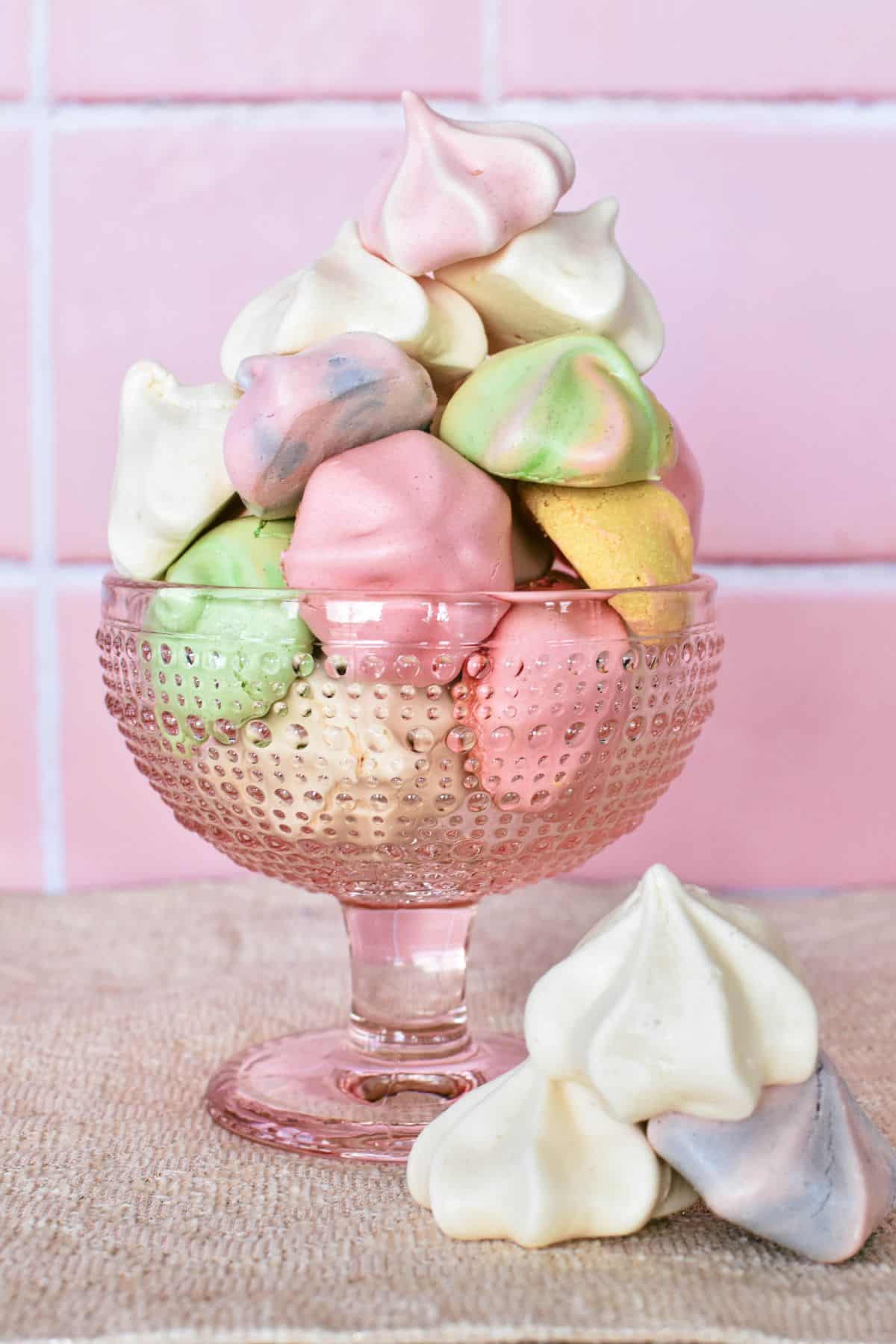
Meringue Kisses are light and crisp throughout. They shouldn’t be soft or chewy. Instead, they’ll melt in your mouth. Also made with sugar and egg whites, pavlova is quite different to meringue – it’s soft and marshmallow-y in the centre with a crisper exterior.
Jump to:
Love at first kiss!
Meringue – even the word sounds delicious! But the reason you’ll love these bite-sized treats comes down to:
- their everlasting popularity: meringue kisses became popular in Europe in the 18th and 19th centuries and were still going strong at Aussie country bakeries in the 1980s when I first fell in love with them
- they look lovely and taste even better: so sweet piled high in a dish, and even sweeter when you enjoy that crisp, melt-in-your-mouth texture
- they are such a versatile treat: place one on a plate as an ideal accompaniment to tea or coffee, enjoy a few in a bowl with ice-cream or use them to decorate a cake
- this recipe has been tested many times to ensure the step-by-step instructions help you avoid all those pesky meringue-making pitfalls: this recipe comes down to the method, which isn’t overly complicated but does involve some tips and tricks to get things right.
Why are they called Meringue Kisses?
It could be the shape or the sweetness? The affection we have developed for these sweets? Whatever the reason, they suit their name.
Indeed, in French, these small meringues are often called “baiser” which literally means “kiss.”
Perhaps it’s also because we can join two of the meringues together with cream, locking them in an eternal kiss.
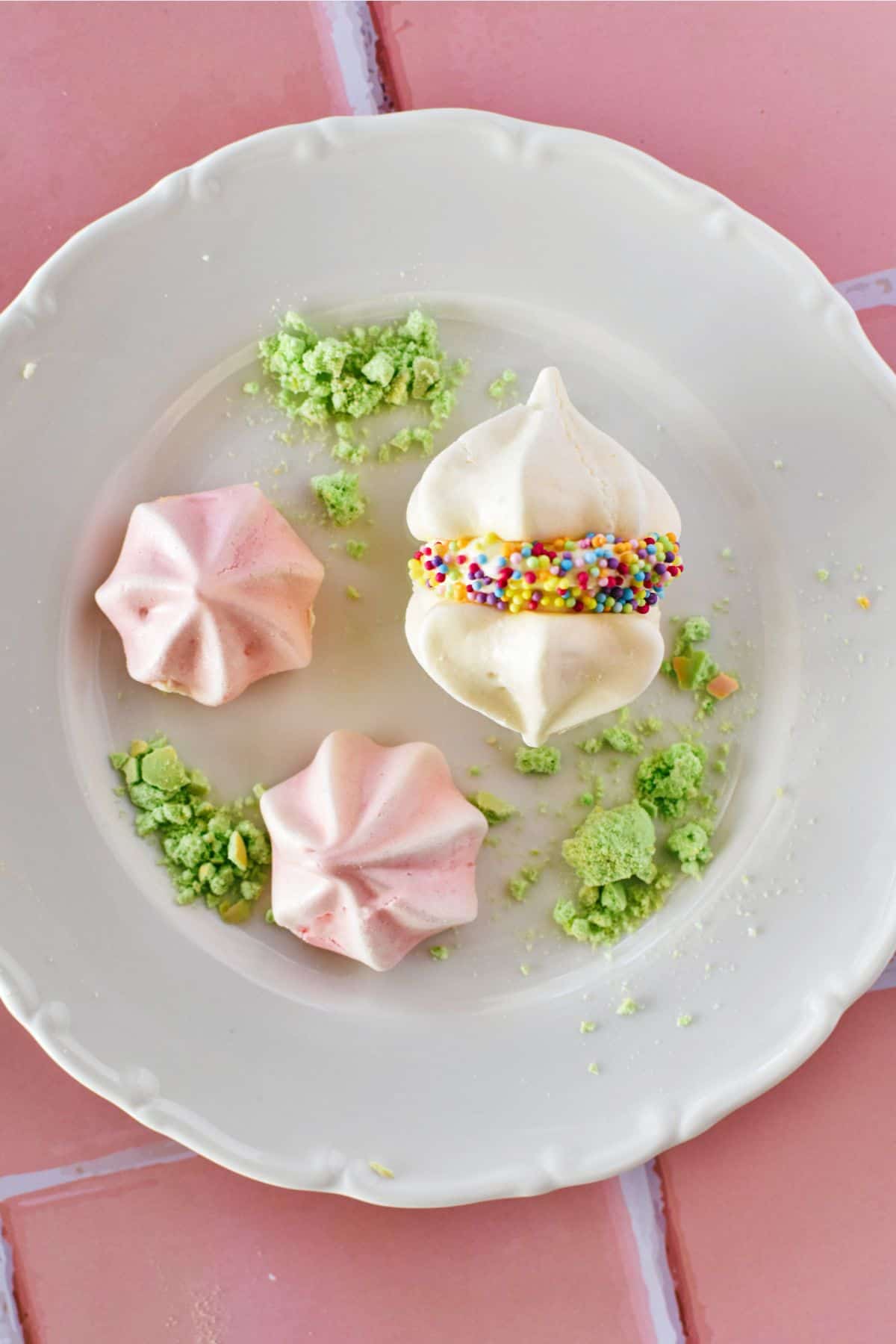
Ingredient notes
You’ll need egg whites and two types of sugar for this recipe – caster sugar (superfine sugar) and icing sugar (powdered sugar).
If you want to go all out and create a range of pastel-coloured meringues, you’ll also need some food colouring.
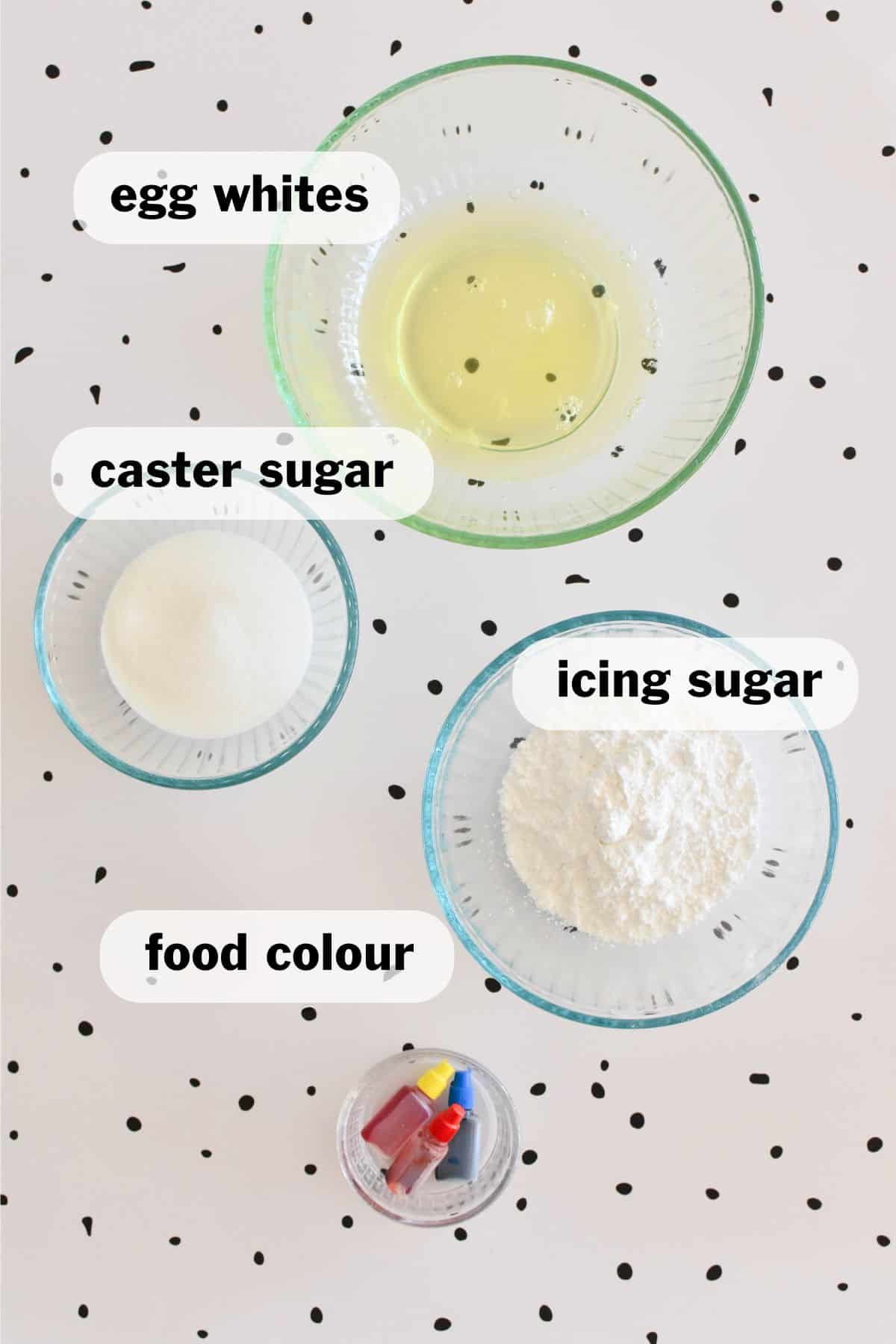
See recipe card below for ingredient measurements.
TIPS:
- The egg whites should be fresh and at room temperature before you attempt this recipe (this will help create more volume, making your meringues light and crisp).
- The egg whites should not contain any yolk, not even a teeny tiny little dot of yolk (the fat from the yolk ruins the ability of the white to fluff up).
- Don’t substitute regular sugar for caster sugar – the finer caster sugar dissolves more easily and ensures a better result.
- You should also sift the icing sugar before adding it. Again, we’re trying to get as much air and lift as possible for perfect meringues.
Equipment notes
To make these tiny treats, these things will come in handy:
- a stand mixer or handheld electric mixer (I thoroughly recommend the stand mixer if you have one as it makes it so much easier to gradually add the sugar having both hands free)
- a piping bag and star nozzle (sure, you can just scoop tablespoons of mixture onto the tray, but who wants a sloppy kiss?)
- baking trays lined with baking paper (you’ll need three).
TIP: Another very important thing to note about equipment is that the bowl and anything else that comes into contact with the ingredients and mixture must be very clean and dry and should ideally be stainless steel or glass. This is because any fat or moisture risks deflating the meringue – and plastic bowls are often difficult to completely clean.
How to make Meringue Kisses
Start by pre-heating the oven to 100 degrees celsius / 210 degrees fahrenheit. Also prepare three baking trays by lining them with baking paper.
Mixing
Place the egg whites into a clean bowl and beat (using a whisk attachment on a stand mixer, ideally). Start off on low speed and gradually increase speed to high.
Continue whisking until the egg whites become frothy and stiff peaks form when you pull the beater form the mixture (see image 1).
Turn the speed to low and gradually add the caster sugar as you continue to whisk.
Increase the speed to high once all sugar has been added, and continue to beat until:
- the mixture looks thick and glossy
- the sugar has dissolved (rub a little of the mixture between two fingers to check this)
- soft peaks form (see image 2).
Fold in the sifted icing sugar. Continue until it’s completely combined but don’t over-mix (see image 3).
Want coloured meringue kisses? Separate mixture into portions, depending on how may colours you are using, and gently stir in a few drops of colour. Again, don’t over-mix.
Piping
Next, place the mixture into a piping bag (with a round or star tip) and squeeze out tablespoons of mixture onto the baking trays lined with baking paper. To get that “kiss” shape, pull bag up quickly towards the end of each meringue (see image 4).
TIP: If you don’t have a piping bag, you can simply spoon tablespoonfuls onto the baking tray.
Baking
Place trays of kisses into the oven and bake for 1 hour and 15 minutes.
Once cooked, switch off oven and leave meringues in oven to cool for another half an hour.
TIP: Before turning off heat, check that meringues easily lift off the baking paper. If still difficult to remove, bake for another 10 minutes and check again. Cooked meringues should easily lift off the paper.
Finally, remove trays from the oven and transfer meringues to cooling rack to finish cooling completely.
Storage
Store completely cooled meringues in an airtight container is a cool, dark place for up to 4 weeks.
Serving and variation ideas
Serve Meringue Kisses on their own or with ice-cream or cream.
Other ideas for creating and serving include:
- add special colours for Christmas or other special occasions
- combine two colours as you pipe them
- add some sprinkles before baking
- use different piping nozzles
- dust cooled meringues with a little cocoa
- perch them atop a cake.
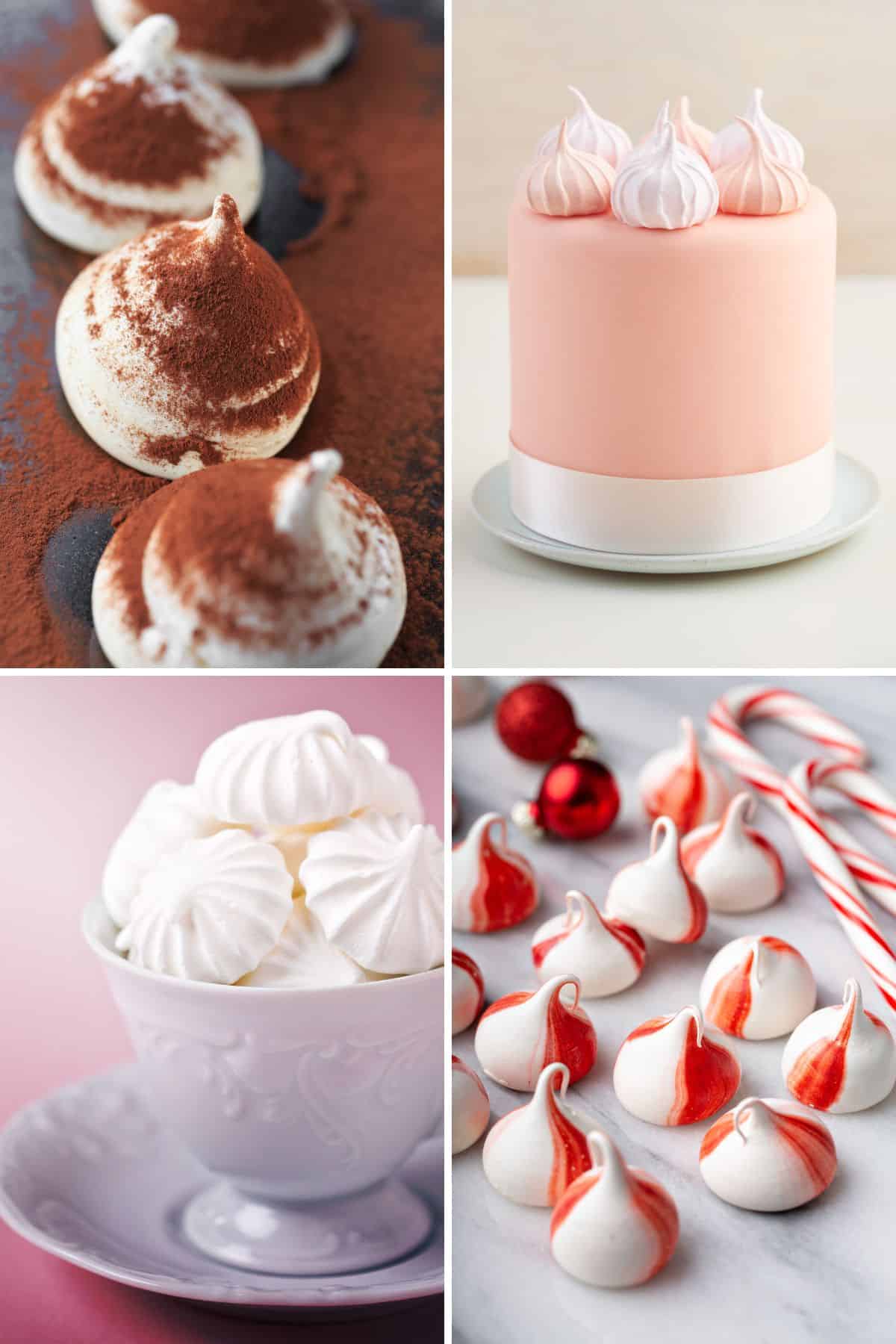
Recipe FAQs
Meringues can crack for a few reasons:
1. If the oven is too hot, the meringues can expand too quickly, leading to cracks as they bake. Meringues require a low, steady temperature to dry out slowly and evenly.
2. If there are changes in temperature. This might happen if you open the oven door while they’re baking or if you remove them from the oven too quickly.
3. If you over-beat the egg whites the meringue mixture can become too stiff and dry, making it prone to cracking during baking.
Chewy meringues can be caused by several factors:
1. Underbaking: If meringues aren’t baked long enough, they won’t dry out completely, resulting in a chewy texture inside. Make sure you bake them low and slow, allowing them to dry out fully, and check whether they can easily be removed from the baking paper (indicating they are cooked) before turning off the heat.
2. Humidity: Meringues are highly sensitive to moisture. If the environment is too humid, the meringues may absorb moisture from the air, making them chewy. It’s best to make meringues on dry days and store them in an airtight container.
Meringues weep when you see shiny liquid droplets on the outside of the meringue. This can happen because of:
1. Overbeating the Egg Whites: Overbeating can cause the egg whites to break down, leading to the release of moisture during baking. Be careful not to over-beat. Stop when peaks form.
2. Undissolved Sugar: If the sugar isn’t fully dissolved into the egg whites, it can cause weeping as the sugar melts during baking. Gradually add the sugar to ensure it dissolves completely. Also ensure you use finer caster sugar rather than regular white sugar.
3. Humidity: Humid conditions can cause meringues to absorb moisture from the air, leading to weeping. Again, it’s best to make meringues in a dry environment and store them properly.
Yes, you absolutely can! Just make sure that you:
1. Cool Completely: Ensure the meringue kisses are completely cooled and dry before freezing them.
2. Store in an Airtight Container: Place the meringue kisses in an airtight container. You can layer them with baking paper to prevent them from sticking together.
3. Freeze: Store the container in the freezer for up to 3 months.
4. Thaw Carefully: When you’re ready to use them, thaw them at room temperature while still in the container. Avoid exposing them to moisture, as this can make them sticky or chewy.
You can, but you’ll need to adjust the baking time accordingly.
More bite-sized beauties
You might also like these teeny tiny treats:
Made this recipe and love it? Please take a moment to rate the recipe and leave a comment below. It’s such a help to others who want to try the recipe. (And it really makes my day to hear how Nana Ling’s recipes are being made, shared and loved all around the world! – Libby x)
For more fun and deliciousness in the kitchen, follow along on Facebook, TikTok and Pinterest, and subscribe for new posts via email.
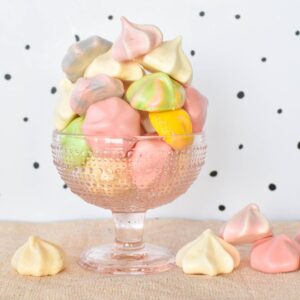
Meringue Kisses
Crisp, delicate and sweet, these bite-sized 3-ingredient meringues are the sweetest of little treats.
Prevent your screen from going dark
Instructions
-
Pre-heat oven to 100 degrees celsius / 210 degrees fahrenheit.
-
Line 3 baking trays with baking paper.
-
Place egg whites into a clean bowl and whisk until frothy and stiff peaks form – starting off slowly and increasing speed to high. (See above post for additional guidance)
-
Slow whisking to a medium speed and gradually add the caster sugar as you continue to whisk. Increase speed to high once all sugar has been added, and continue to beat until the mixture looks thick and glossy, the sugar has dissolved (feel a little of the mixture between two fingers) and soft peaks form.
-
Fold in sifted icing sugar until combined. Take care not to over-mix.
-
If adding colour, separate mixture into portions, depending on how may colours you are using, and gently stir in a few drops of colour.
-
Place mixture into a piping bag (with a round or star tip) and squeeze out tablespoons of mixture onto the baking trays lined with baking paper. To get that “kiss” shape, pull bag up towards the end of each meringue. If you don’t have a piping bag, you can simply spoon tablespoonfuls onto the baking tray.
-
Place into oven and bake for 1 hour and 15 minutes. Before turning off heat, check that meringues easily lift off the baking paper. If still difficult to remove, bake for another 10 minutes and check again. Cooked meringues should easily lift off the paper.
-
Once cooked, switch off oven and leave meringues in oven to cool for another half an hour.
-
Remove from oven and transfer meringues to cooling rack to finish cooling completely.
Notes
Freezing: Freeze completely cooled meringues in an airtight container for up to 3 months.
Nutrition: The nutrition information is an automatically generated estimate and is not guaranteed to be accurate.
Tips:
- The egg whites should be fresh and at room temperature.
- The egg whites should not contain any yolk.
- Don’t substitute regular sugar for caster sugar .
- You should also sift the icing sugar before adding it.
- Ensure bowl and other equipment is very clean and dry.
Nutrition
Calories: 26kcalCarbohydrates: 6gProtein: 0.4gFat: 0.02gSodium: 6mgPotassium: 6mgSugar: 6gCalcium: 0.3mgIron: 0.01mg
Discover more from reviewer4you.com
Subscribe to get the latest posts to your email.





